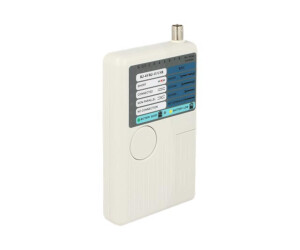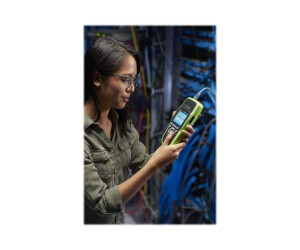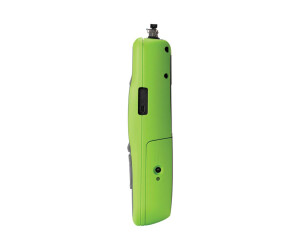











A network tester is an indispensable tool in the information technology (IT) and telecommunications industry, designed to check, analyze, and improve the integrity and performance of networks. It allows professionals to test the functionality of networks, diagnose problems, and optimize the quality of network connections. Here is a detailed description of a network tester:
1. Physical Characteristics:
1. Portability and Mobility: A network tester is designed to be handy and lightweight. With moderate dimensions, it can be effortlessly held in one hand. This feature allows the user to conveniently transport and use the device, even in hard-to-reach places or confined environments.
2. Ergonomic Design: The ergonomics of a network tester are crucial to ensure that it fits comfortably in the hand and can be used for extended periods without causing fatigue. The shape, weight distribution, and arrangement of controls are carefully designed to ensure ergonomic handling.
3. Robust Casing: The casing of a network tester is typically made of durable materials such as plastic or metal. These materials serve to protect the device from external influences like shocks, scratches, and dirt. This ensures the durability of the device, even in demanding work environments.
4. Environmental Protection: The robust casing provides effective protection against various environmental influences. It can be shock-resistant to ensure that the interior of the device is protected from damage due to accidental impacts. Additionally, it is often splash-proof and dust-resistant, enabling use in different environments, whether outdoors or in industrial settings.
5. Choice of Materials: Depending on the manufacturer and model, network testers may use different materials for the casing. Plastics may be lighter and offer better grip, while metal casings can provide additional robustness and stability.
6. Display and User Interface: The network tester is equipped with an integrated display, which may use TFT, LCD, or LED technology depending on the model. This display shows information such as test results, parameters, and configuration options. The user interface is intuitively designed to facilitate easy operation. This may be a combination of physical buttons and a touchscreen.
2. Display and User Interface:
1. Display Technology:
2. Display Contents:
3. Intuitive User Interface:
4. User Comfort:
5. Customization Options:
3. Testing Functions:
1. Cable Length Measurement:
2. Signal Strength and Quality:
3. Continuity Testing:
4. Wire Mapping:
5. Network Identification:
6. PoE (Power over Ethernet) Testing:
7. Ping and Traceroute:
4. Power Supply and Battery:
1. Power Source: Network testers are typically equipped with rechargeable batteries for portable use. They may also have the option to be powered by AC mains for extended testing sessions.
2. Battery Life: The battery life of a network tester can vary depending on factors such as usage intensity and the capacity of the battery. Some models offer long-lasting batteries to ensure uninterrupted testing sessions.
3. Charging Time: The charging time required to fully charge the battery is an important consideration for professionals who rely on the network tester for their daily tasks. Fast-charging capabilities can be a valuable feature.
4. Battery Status Indicator: A battery status indicator on the display provides information about the remaining battery life, ensuring that the user is aware of when it's time to recharge the device.
5. Connectivity Options:
1. Ports and Interfaces: Network testers come with a variety of ports and interfaces to facilitate connections to different types of network equipment. Common interfaces include Ethernet ports, USB ports, and coaxial connectors.
2. Wireless Connectivity: Some advanced network testers may also offer wireless connectivity options, such as Wi-Fi or Bluetooth, for enhanced versatility in connecting to different types of networks.
6. Additional Features:
1. Memory and Storage: Network testers may include built-in memory or storage capabilities for saving test results, configurations, and other data. This allows for easy access to previous test data and the ability to generate reports.
2. Firmware Updates: Manufacturers may release firmware updates to enhance the functionality and features of the network tester. The ability to easily update the firmware ensures that the device remains up-to-date with the latest technology and standards.
3. Carrying Case: A dedicated carrying case or bag provides a convenient and protective way to transport the network tester between job sites.
4. Accessories: Depending on the model, network testers may come with various accessories, such as specialized cables, adapters, and probes, to accommodate different testing scenarios.
7. Applications:
1. Installation and Maintenance: Network testers are used during the installation and maintenance of network infrastructures. They help ensure that connections are properly established and meet performance standards.
2. Troubleshooting: When network issues arise, a network tester is an invaluable tool for diagnosing problems and identifying the source of the issue. This speeds up the troubleshooting process and minimizes downtime.
3. Certification and Compliance: Network testers are used to certify that network installations comply with industry standards and regulations. This is particularly important in professional network installations and data centers.
4. Security Audits: Network testers can be used in security audits to identify vulnerabilities and assess the overall security of a network. This helps organizations protect their data and infrastructure from potential threats.
5. Network Optimization: By analyzing network performance and quality, network testers provide insights that can be used to optimize network configurations and settings for improved efficiency and reliability.
8. Conclusion:
A network tester is an essential tool for IT and network professionals involved in the installation, maintenance, and troubleshooting of network infrastructures. It provides a wide range of testing capabilities, including cable length measurement, signal quality assessment, continuity testing, wire mapping, network identification, PoE testing, and diagnostic tools like ping and traceroute. Considerations for selecting a network tester include its testing capabilities, display features, power supply options, connectivity interfaces, additional features like memory and storage, and applications for specific use cases.
When choosing a network tester, it's important to evaluate its compatibility with the specific network environments and equipment it will be used with. Additionally, considering factors like battery life, portability, and durability can contribute to a more effective and reliable testing experience. By selecting the right network tester for the job, professionals can ensure the integrity and performance of network connections in a wide range of applications.
Remember to refer to the user manual and follow best practices for safe and accurate use of the network tester. Regular calibration and maintenance, if required, will also contribute to its long-term effectiveness and reliability.





| id | title | mpn | price | manufacturer |
|
from *
/ |

